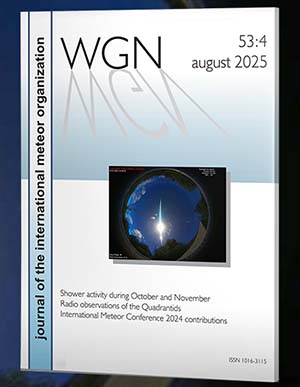After several months of low activity the meteor
rates for both hemispheres see a marked increase in July. In the northern hemisphere
the change is not noticeable until mid-month when several southern radiants, the
Perseids, and sporadic rates all increase in activity. Southern rates are good all
month long. It should be noted that enhanced activity from the June Bootids is
possible during this period. The maximum is expected near 0200 Universal Time on
June 28th. This corresponds to 2200 or 10pm EDT on Sunday evening June 27th. The
full moon will hinder observations but the June Bootids can be bright so it is
suggested that you scan the skies as soon as it becomes dark on Saturday evening.
The last outburst from this shower in 1998 lasted nearly 24 hours. These meteors
are very slow and come from a radiant that lies nearly overhead for mid-northern
observers at dusk.
During this period the moon reaches its full
phase on Saturday June 26th. At this time the moon will be located opposite the
sun and will remain in the sky all night long. Later next week a small window of
opportunity exists for viewing in dark skies just after the end of evening twilight
as the moon rises later in the evening. The estimated total
hourly rates for evening observers this week is near one for northern observers
and two for those viewing from south of the equator. For morning observers the
estimated total hourly rates should be near three from the northern hemisphere
and eight as seen from the southern hemisphere. The actual rates will also
depend on factors such as personal light and motion perception, local weather
conditions, alertness and experience in watching meteor activity. Rates
are reduced during this period due to the intense moonlight.
The radiant (the area of the sky where meteors appear
to shoot from) positions and rates listed below are exact for Saturday night/Sunday
morning June 26/27. These positions do not change greatly day to day so the listed
coordinates may be used during this entire period. Most star atlases (available at
science stores and planetariums) will provide maps with grid lines of the celestial
coordinates so that you may find out exactly where these positions are located in
the sky. A planisphere or computer planetarium program is also useful in showing
the sky at any time of night on any date of the year. Activity from each radiant
is best seen when it is positioned highest in the sky, either due north or south
along the meridian, depending on your latitude. It must be remembered that meteor
activity is rarely seen at the radiant position. Rather they shoot outwards from
the radiant so it is best to center your field of view so that the radiant lies
at the edge and not the center. Viewing there will allow you to easily trace the
path of each meteor back to the radiant (if it is a shower member) or in another
direction if it is a sporadic. Meteor activity is not seen from radiants that are
located below the horizon. The positions below are listed in a west to east
manner in order of right ascension (celestial longitude). The positions listed
first are located further west therefore are accessible earlier in the night while
those listed further down the list rise later in the night.
The full descriptions of each active meteor shower will continue next week
when the moon becomes less of a nuisance to observers.
The list below presents a summary of the expected activity this week. Rates
and positions are exact for Saturday night/Sunday morning but may be used
all week.
| SHOWER | DATE OF MAXIMUM ACTIVITY | CELESTIAL POSITION | ENTRY VELOCITY | CULMINATION | HOURLY RATE | CLASS* | RA (RA in Deg.) DEC | Km/Sec | Local Daylight Time | North-South | June Bootids (JBO) | Jun 27 | 14:56 (224) +48 | 18 | 22:00 | <1 - 0 | III | f-Ophiuchids (FOP) | Jun 29 | 17:12 (258) +10 | 21 | 00:00 | <1 - <1 | IV | Antihelion (ANT) | – | 19:12 (288) -22 | 30 | 02:00 | 1 – 2 | II |




 You saw something bright and fast? Like a huge shooting star? Report it: it may be a fireball.
You saw something bright and fast? Like a huge shooting star? Report it: it may be a fireball.  You counted meteors last night? Share your results with us!
You counted meteors last night? Share your results with us!  You took a photo of a meteor or fireball? You have a screenshot of your cam? Share it with us!
You took a photo of a meteor or fireball? You have a screenshot of your cam? Share it with us!  You caught a meteor or fireball on video? Share your video with us!
You caught a meteor or fireball on video? Share your video with us!